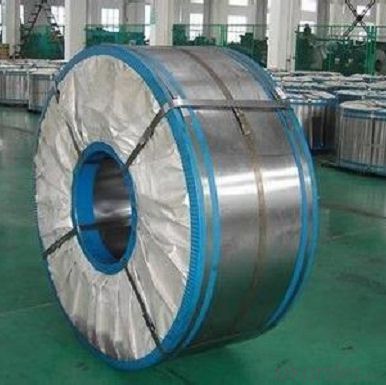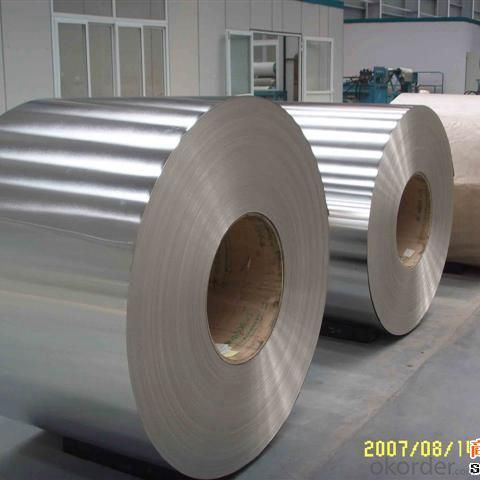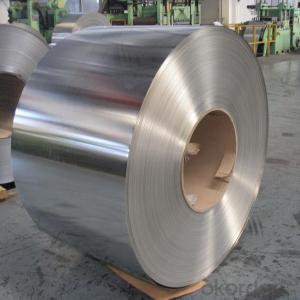Tinplate for Food Pakcaging and Chemical Packaging
- Loading Port:
- Tianjin
- Payment Terms:
- TT OR LC
- Min Order Qty:
- 50 m.t.
- Supply Capability:
- 30000 m.t./month
OKorder Service Pledge
OKorder Financial Service
You Might Also Like
Item specifice
Tinplate for Food Pakcaging and Chemical Packaging
Specifications
Prime electrical tinplate:
Thickness: 0.15 to 0.50mm
Width: 600 to 1010mm
Temper grade: BA and CA
For metal packaging usage
The Tinplate specification as following:
1, Reference standard: GB2520-88, JIS G3303-1997 and DIN EN10203-91
2, Material: MR, SPCC
3, Thickness available: 0.15mm to 0.50mm
4, Width available: 600mm to 1010 mm
5, Temper grade: T1 - T5 BA and CA both.
6, Tin coating: ordinary 2.8g/2.8g, 5.6g/5.6g, We also can produce according to customers' requests
7,Coil diameter: ID 420/ 508mm, OD from 1,000 to 1,250mm
8,Package: Anti-rust paper,corner protected. by sheet or coils according customer's require.
9, Applications: metal package usage like paint, chemical can,aerosol can and different food can production,
Also battery,electric cable and other industries


| Tinplate specifications | |||
| Steel Type | SPCC, MR | ||
| Temper(BA&CA) | T1~T5 | ||
| Coating | 1.1~11.2g/m2 | ||
| Thickness and tolerance | 0.15~0.50mm(Tolerance: _+0.01 mm) | ||
| Width & tolerance | 300~1000mm (Tolerance: 0~3mm) | ||
| Cut length & tolerance | 450~``50mm (Tolerance: 0~3mm ) | ||
| Coil inside diameter | 420/508mm | ||
| Coil Weight | 3~10 MT | ||
| Passivation | 311 | ||
| Oiling | DOS | ||
| Surface Finish | Bright, Stone, Silver, Matte | ||
| Packaging | Seaworthy Standard with wooden pallet | ||
| Standards Available | GB/T2520, JIS G3303, ASTM A623M & EN10202 | ||
| Special specitications are available on request. | |||
| Tin coating weight | |||
| Type | Designation of tin coating weight | Min.average tin coating weight(g/m2) | Former Coating Designation |
| Equal tin coating | 1.4/1.4 | 1.2/1.2 | #15 |
| 2.2/2.2 | 2.0/2.0 | #20 | |
| 2.8/2.8 | 2.45/2.45 | #25 | |
| 5.6/5.6 | 5.05/5.05 | #50 | |
| 8.4/8.4 | 7.55/7.55 | #75 | |
| 11.2/11.2 | 10.1/10.1 | #100 | |
| Differentially Coating | 1.4/2.8 | 1.2/2.45 | #15/25 |
| 2.2/2.8 | 2.2/2.45 | #20/25 | |
| 2.8/5.6 | 2.45/5.05 | #25/50 | |
| 2.8/8.4 | 2.45/7.55 | #25/75 | |
| 2.8/11.2 | 2.45/10.1 | #25/100 | |
| 5.6/8.4 | 5.05/7.55 | #50/75 | |
| 5.6/11.2 | 5.05/10.1 | #50/100 | |
| 8.4/11.2 | 7.55/10.1 | #75/100 | |
| Surface finish | |||
| Surface finish | Nominal surface roughness (um Ra) | Characteristic | |
| Bright finish | ≤Q0.35 | Glazed surface obtained after melting treatment of electrotinned smooth raw materail strip with extremely fine rubstone fingure by processing. | |
| Stone finish | 0.25~0.60 | Glazed surface obtained after melting treatment of electrotinned smooth raw materail stripfeaturing certain rubstone figures. | |
| Silver finish | 0.50~1.00 | Glazed surface obtained after melting treatment of electrotinned smooth raw material strip with rough matt furface. | |
| Matte finish | 0.80~2.50 | Matt surface of general matt raw material strip without melting treatment. | |
- Q:How does tinplate affect the overall product tamper-evident features?
- Tinplate enhances the tamper-evident features of a product by providing a strong and durable packaging material. Its rigidity and resistance to punctures or tampering make it difficult for unauthorized access or tampering. Additionally, tinplate can be sealed tightly, ensuring that any attempt to open the product is easily detectable. Overall, tinplate plays a crucial role in enhancing the tamper-evident features of a product, ensuring its integrity and safety.
- Q:How is tinplate coated for chemical storage containers?
- Tinplate is typically coated for chemical storage containers using a process called electrolytic tin plating, where a layer of tin is electrochemically deposited onto the surface of the steel substrate. This tin coating helps to protect the container from corrosion and chemical reactions, ensuring safe storage and transportation of chemicals.
- Q:What are the main factors influencing the consumer preferences for tinplate packaging?
- The main factors influencing consumer preferences for tinplate packaging include its recyclability and sustainability, durability and protective properties, aesthetic appeal and branding opportunities, as well as its ability to preserve product quality and freshness.
- Q:How is tinplate coated for signage?
- Tinplate for signage is typically coated using a process called electroplating, where a layer of tin is deposited onto the surface of the metal. This coating provides protection against corrosion and enhances the appearance of the signage.
- Q:How can tinplate be customized for branding purposes?
- Tinplate can be customized for branding purposes through various methods such as printing, embossing, and labeling. The use of high-quality printing techniques allows for intricate designs, logos, and product information to be directly printed on the tinplate surface. Embossing techniques can add a three-dimensional effect to the branding, making it visually appealing and unique. Additionally, labels can be affixed to the tinplate, providing flexibility in changing branding elements or promoting different product lines. These customization options help businesses effectively market their brand and enhance their product's visibility on store shelves.
- Q:How is tinplate used in the cosmetics industry?
- Tinplate is commonly used in the cosmetics industry for packaging purposes. It is used to create metal containers, such as tin cans or tubes, that house various cosmetic products like creams, lotions, or powders. Tinplate's durability and resistance to corrosion make it an ideal material for ensuring the safety and longevity of cosmetic products. Additionally, its attractive appearance allows for branding and customization options, enhancing the overall appeal of the product.
- Q:Can tinplate be used for packaging cosmetics?
- Yes, tinplate can be used for packaging cosmetics. Tinplate is a type of steel coated with a thin layer of tin, which provides excellent protection against oxidation and corrosion. It is commonly used in the packaging industry due to its durability, versatility, and ability to maintain the quality and integrity of products. Tinplate packaging for cosmetics offers a sleek and attractive appearance while ensuring the safety and preservation of the cosmetic products.
- Q:How does tinplate compare to other packaging materials in terms of sustainability?
- Tinplate is considered to be a highly sustainable packaging material when compared to others. It is infinitely recyclable without losing its properties, making it a preferred choice for many industries. Tinplate also has a lower carbon footprint and energy consumption during its production compared to other packaging materials like plastic or glass. Additionally, tinplate offers excellent protection and preservation qualities, extending the shelf life of products and reducing food waste. Overall, tinplate stands out as a more environmentally friendly option in terms of sustainability in packaging.
- Q:How is tinplate recycled and what are the benefits of recycling?
- Tinplate is recycled through a process called "metal reclamation," which involves collecting and separating tin-coated steel from other materials. The tin coating is removed, and the steel is melted down and used to produce new tinplate products. The benefits of tinplate recycling are numerous. Firstly, it conserves natural resources by reducing the need for mining and extracting raw materials. Additionally, recycling tinplate reduces energy consumption and greenhouse gas emissions associated with the production of new tinplate. Moreover, recycling tinplate helps minimize waste disposal in landfills, which reduces environmental pollution and conserves landfill space. It also contributes to the circular economy by promoting the reuse of materials and extending the lifespan of tinplate products. Overall, tinplate recycling is a sustainable practice that brings economic, environmental, and social benefits.
- Q:What are the recommended soldering techniques for tinplate?
- The recommended soldering techniques for tinplate include pre-tinning the surfaces to be soldered, using a low-temperature soldering iron, ensuring proper ventilation, and using flux to promote good solder flow. It is also important to avoid excessive heat, as tinplate can be easily damaged.
1. Manufacturer Overview |
|
|---|---|
| Location | |
| Year Established | |
| Annual Output Value | |
| Main Markets | |
| Company Certifications | |
2. Manufacturer Certificates |
|
|---|---|
| a) Certification Name | |
| Range | |
| Reference | |
| Validity Period | |
3. Manufacturer Capability |
|
|---|---|
| a)Trade Capacity | |
| Nearest Port | |
| Export Percentage | |
| No.of Employees in Trade Department | |
| Language Spoken: | |
| b)Factory Information | |
| Factory Size: | |
| No. of Production Lines | |
| Contract Manufacturing | |
| Product Price Range | |
Send your message to us
Tinplate for Food Pakcaging and Chemical Packaging
- Loading Port:
- Tianjin
- Payment Terms:
- TT OR LC
- Min Order Qty:
- 50 m.t.
- Supply Capability:
- 30000 m.t./month
OKorder Service Pledge
OKorder Financial Service
Similar products
New products
Hot products
Related keywords






























